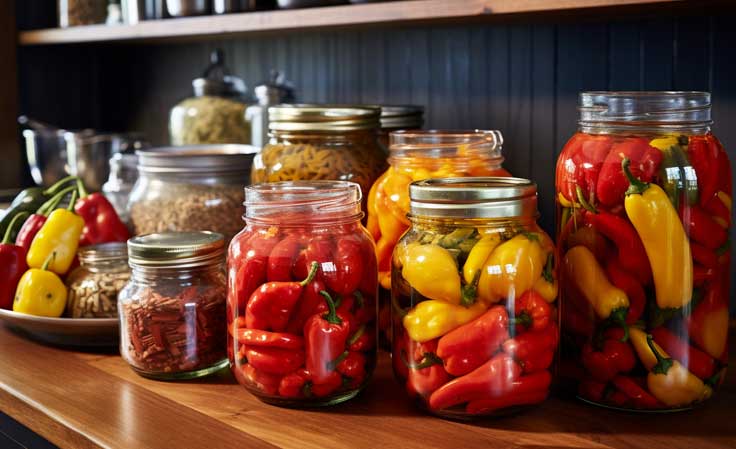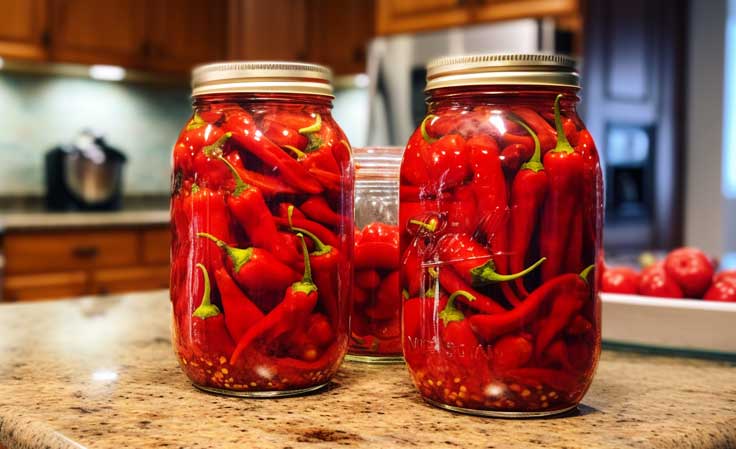Are you a fan of spicy foods and looking to add an extra kick to your meals? Fermented peppers might just be the answer you're looking for. Not only do they enhance the flavor of your dishes, but they also come with a host of health benefits in comparison to traditional pickled peppers.
Pickling uses vinegar which is an end product of fermentation. With fermentation, you use salt and water to ferment an item and that environment becomes an active playground for gut-healthy bacteria. I love pickled peppers, so I figured I would up my game by fermenting for added health benefits and flavor! In this ultimate guide, I will walk you through everything you need to know about making fermented peppers at home.
What Are Fermented Peppers?
Before we dive into the process of making fermented peppers, let's understand what they are. Fermented peppers are hot peppers that have undergone a fermentation process, typically involving salt and water. This process not only preserves the peppers but also transforms their flavor profile, making them tangy, spicy, and full of probiotics.
If you like pickled peppers, like I do, there is a high likelihood you will also enjoy fermented peppers. They both host a tangy flavor, just one has added health benefits due to the process of making it (fermentation.)
Benefits of Consuming Fermented Peppers
Fermented peppers offer numerous health benefits, making them a great addition to your diet. If you aren’t enjoying fermented foods yet, what are you doing? Sourdough is fermented bread, and is absolutely delicious! Kefir is fermented milk. Sauerkraut is fermented cabbage. We are surrounded by a plethora of fermented foods at the store, but you can very easily make fermented foods in your kitchen.
Here are some reasons why you should consider including them in your meals:
1. Rich in Probiotics
Fermented peppers are packed with probiotics, the beneficial bacteria that promote a healthy gut. A healthy gut is essential for overall well-being and can boost your immune system. Probiotics help maintain the balance of beneficial and harmful bacteria in your gut, improving digestion and nutrient absorption. There is a saying that if you have a health problem, consult your gut. Is your microbiome thrown off? Have antibiotics eliminated your healthy gut? Have you been nourishing your gut? One way to nourish your gut is with fermented peppers!
2. Improved Digestion
The probiotics in fermented peppers can aid digestion, reducing issues like bloating and indigestion. They also enhance nutrient absorption, ensuring you get the most out of your food. If you often experience digestive discomfort, incorporating fermented peppers into your diet may provide relief. The discomfort can be due to a build of nutrients that weren’t able to be absorbed for one reason or another, fermented peppers can assist in digestion and absorption to eliminate discomfort.
3. Spicy Flavor
If you love spicy food, fermented peppers are a must-try. The fermentation process intensifies the heat, giving your dishes a flavorful punch. Whether you enjoy them in sauces, salsas, or as a garnish, fermented peppers can add a delicious and fiery dimension to your meals.
While pickling doesn’t add a boost of heat, in my opinion, fermenting can definitely enhance the overall spiciness so be weary!
4. Long Shelf Life
Fermentation acts as a natural preservative, allowing you to store your peppers for an extended period without the need for refrigeration. This means you can enjoy the flavors of summer peppers all year round. I am all about food storage, so if fermentation allows me to store food longer without electricity, I am here for it!

Choosing the Right Peppers
The first step in making fermented peppers is selecting the right type of peppers. Here are some popular choices:
1. Jalapeños: Mild and versatile, jalapeños are a great choice for beginners. They have a pleasant level of heat and can be used in various dishes, from tacos to pickles. These are my preference as I don’t want to be in pain due to heat. They pack the perfect punch for me!
2. Habaneros: For those seeking a serious heat kick, habaneros are a top pick. These fiery peppers will add a substantial amount of heat to your ferment.
3. Anaheim Peppers: These peppers have a smoky flavor and are perfect for those who enjoy a mild, smoldering taste. They are commonly used in dishes like chili and roasted pepper recipes.
4. Serrano Peppers: Serranos offer a balanced level of heat and are widely used in Mexican cuisine. They add a zesty kick to salsas and sauces, making them a favorite among spice enthusiasts. I love serrano peppers on my breakfast burritos.
Ingredients You'll Need
Gather the following ingredients to get started:
- Fresh peppers of your choice
- Non-chlorinated water
- Sea salt or kosher salt
- Garlic cloves (optional)
- Fermentation weights
Step-by-Step Guide to Making Fermented Peppers
Step 1: Prepare Your Peppers
Wash and rinse the peppers thoroughly. This removes any dirt or contaminants from the surface. Especially if you are pulling these from your garden, check the crevices for dirt.
Cut the peppers into slices or leave them whole, depending on your preference. Remember to keep the stems intact if you prefer.
Step 2: Prepare the Brine
Dissolve 2-3% salt in non-chlorinated water to create a brine solution. The exact salt-to-water ratio can vary depending on your taste preferences. Chlorinated water can affect the fermentation process, so use a filter on your tap if possible.
Step 3: Pack the Peppers
Place the pepper slices and garlic cloves (if desired) into a clean, sterilized glass jar. The jar should be large enough to hold your peppers comfortably.
Pour the prepared brine over the peppers, ensuring they are completely submerged. Leave some headspace at the top of the jar to allow for gas expansion during fermentation.
Step 4: Add Weights
To prevent the peppers from floating to the surface, place fermentation weights on top. These weights will hold the peppers beneath the brine, preventing spoilage.
Step 5: Fermentation Process
Seal the jar with an airlock lid or a loosely screwed-on lid. An airlock allows gases produced during fermentation to escape while preventing oxygen from entering the jar. These are handy to have in your kitchen for fermentation recipes like this one.
Store the jar in a cool, dark place for about one to two weeks, checking it periodically. You should see bubbles forming, which is a sign that fermentation is taking place. The brine may also become cloudy, which is normal.
Step 6: Taste Test
After a week, start tasting your fermented peppers. The longer they ferment, the tangier and spicier they will become. If they've reached the desired flavor, they're ready to be used. If not, let them ferment for another week or longer until you achieve the desired taste.
Creative Uses for Fermented Peppers
Now that you've successfully made your batch of fermented peppers, it's time to explore their culinary potential. Here are some creative ways to enjoy your spicy creations:
1. Homemade Hot Sauce
Blend your fermented peppers with vinegar and other seasonings to create a personalized hot sauce. Adjust the ingredients to achieve your preferred level of heat and flavor. Seriously, fermented peppers will make the best hot sauce. Conventional hot sauces from the store pale in comparison.
2. Fermented Pepper Paste
Mash your fermented peppers into a paste, adding a touch of olive oil for a smoother texture. Use this flavorful paste as a condiment, marinade, or base for spicy dishes. I will add a dash of the paste on my toast. Toast is so versatile with toppings, so this makes a fresh summer twist.
3. Pickled Fermented Peppers
Transfer your fermented peppers to a clean jar, cover them with vinegar, and store them in the refrigerator. These pickled peppers can be enjoyed as a zesty addition to salads, sandwiches, or antipasto platters. Yes, pickled fermented peppers, probably the best kind of pepper ever.
4. Spicy Fermented Salsa
Combine your fermented peppers with fresh tomatoes, onions, cilantro, and lime juice to create a fiery salsa. Serve it with tortilla chips, tacos, or grilled meats.
Get Fermenting!
In this comprehensive guide, we've explored the world of fermented peppers, from their health benefits to the step-by-step process of making them at home. If you have a small spot to grow peppers, do it. You will love the taste of homegrown peppers and enjoy the variety that you are able to grow.
By following these instructions and experimenting with different pepper varieties and flavors, you can create your own signature batch of fermented peppers to elevate your culinary creations in your homestead kitchen. So, spice up your meals and enjoy the unique flavors and health benefits that fermented peppers have to offer. Happy fermenting!

